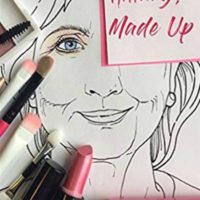As I was reading Marianne Kunkel’s debut poetry collection, Hillary, Made Up, a phrase kept passing through my mind like ticker tape—”the wish to replace it with something else.” For a while, I struggled to recall the phrase’s origin, and then I wondered why these words hovered so persistently above the pages of this book. I have since realized the answer is at the heart of Kunkel’s sharp and nuanced intentions in writing it.
You see, the phrase in question comes from Susan Sontag’s iconic 1966 essay, “Against Interpretation,” and belongs to a longer section that reads: “It is always the case that interpretation […] indicates a dissatisfaction (conscious or unconscious) with the work, a wish to replace it with something else.” (If you’ve already replaced “work” with “women,” “it” with “her,” and “something else” with “men,” congratulations on your astute substitutions! Meet me at the bottom of the next paragraph.)
Hillary, Made Up is a complex feminist undertaking that undermines traditional notions of interpretation. For instance, this is not a book that seeks to explain how Hillary Clinton lost the White House to Donald Trump in 2016, or how she lost the Democratic nomination to Barack Obama in 2008. Neither is it a book that seeks to argue why Hillary Clinton should have won the White House or become the first female President of the United States. And while this project does explore gendered incongruities in American politics through the life of one well-known female politician, Kunkel’s approach to her title subject is less rooted in the aspects of Clinton’s life that make her exceptional (though there are many) and more in the aspects that make her typical. After all, Hillary Clinton is a woman living and aging, working and striving, in a culture that remains deeply dissatisfied with women—a culture that, by turns conscious and unconscious, wishes to replace them with something else.
Occam’s razor would suggest this “something else” is, most often, men. Yet when women occupy positions in the public sphere, or positions already reserved for them within the private sphere of patriarchal society, e.g. wives to men and mothers to their children, it is invariably a lighter, softer, prettier, airier, younger, more radiant version of themselves with which they are being replaced. Sometimes the replacement is a literal “other woman,” and sometimes it’s the metaphorical “new woman” our lively, aging, working, striving woman becomes when she transforms her appearance with styling products.
If you’ve never stopped to think about how many such products the average woman might use in her “beauty regimen”—let alone a woman who has spent the last half-century in the public eye—fear not: Marianne Kunkel has! In thirty-nine poems, arranged according to the physical attributes EYE, SKIN, and HAIR, this conceptually innovative poet contemplates thirty-nine different methods by which a woman’s appearance can be modulated, repaired, disguised, or otherwise controlled. These include widely recognized “beauty aids” like tweezers, mascara, nail polish, and hair dye, as well as the less familiar (at least to me) brow gel, lip plumper, face primer, and setting spray.
I think Kunkel’s project is a fascinating and ambitious one, even if she had confined herself to a poetic biography of an influential woman in light of the styling products that shaped her public life. (Even!). It turns out this book is that biography, but with a significant twist—the styling products are narrating the poems.
Here, have a listen as Kunkel writes as “White Eyeliner to Hillary”:
The cocaine of make-up,
I turn an exhausted face
into a hopped-up, hyped-out
who’s-ready-to-party
mask. Just ask the stylist
who, after your flight
from L.A. to Brooklyn,
dabbed then smudged me
on the inner corners of your eyes.
At that night’s debate
you were brighter than
Bernie’s hair, your skin
the highest-watt porch light
on a twinkly street.
And here, as “False Eyelashes to Hillary”:
I’m starting to think I’m the only makeup
you’ve truly quit. I’m the kind
not meant to make lovely features lovelier,
but to replace all women’s lashes
with little uniform brooms.
I remind you that sometimes fake is better.Viewers don’t get to see your towel-blotted face,
your puffed cheeks as you swish mouthwash,
or hear your gentle hum
of an old Welsh song
so pretty, so undecorated.
And here, this superlative insight, as “Blush to Hillary”:
I’m the outrage women can’t show,
a simulated ruby stain standing in
for a stamped-out flame.
My students consistently tell me that our unit on persona poetry is the most difficult in the Poetic Techniques class I teach. “When you ask us to write as someone else,” they say, “we have to do a lot of research in order to make it work. We have to really get to know the person before we can even imagine trying to embody them.” Yes, exactly!
Now imagine the research required to plumb the life of Hillary Clinton—from her early years working for Senator Mondale’s Subcommittee on Migratory Labor and Edelman’s Children’s Defense Fund through her years as First Lady, Presidential Hopeful, Secretary of State, Presidential Hopeful Again (this time as Democratic Nominee for President) through her concession speech and post-election appearances—and then to depict that life through such a specific and extensive range of styling products. A deep knowledge is needed, coupled with a deep empathy, and these must also be informed by an imaginative—dare I say subversive—sensibility regarding point of view.
Oh, and did I mention the sonnets? There are sonnets! Some of the poems, like “Brow Brush to Hillary,” demonstrate poetic biography vis-à-vis unique persona vis-à-vis neoformalism. Here is a taste from one impeccably made sonnet post-volta:
Meanwhile, I rake your clipped brows into place,
Frequently pausing so stylists can pluck
A few distracting hairs, or fill bald space
They over-plucked. The next unshaven shmuck
Who wishes you good luck before a speech
Will see me bristle—luck is men’s private beach.
Kunkel is working a meta-angle here, as well. She’s writing about stylists throughout this collection while serving as a stylist herself. (It can’t be pure coincidence that stylus is another, older word for writing implement.) Her project is deceptive in that the poem-pages, like made-up faces, appear crisp and clean, the language clear and blemish-free. The challenges of Kunkel’s intricate literary enterprise have been erased by the precision of her revisions, much like the “pimples, blackheads, whiteheads” and “wrinkles, age spots, spider veins” the concealer conceals on Hillary Clinton.
My favorite poem from the collection comes near the end in the section called HAIR. Here the comb speaks as Hillary, weeks after the lost election, she lies reading on her bed:
________Unexpectedly
Chelsea rang, and in a rush
________to mark your pageyou snatched me from a stylist’s pile
________of hair supplies,
forgotten in your bathroom
________post-campaign. […]I wasn’t home but I was comfortable
________in smooth paper,
my topmost teeth peeking out
________for your return.Like a skilled politician
________you found me work.
Now I dream of what else I can be:
_______baton, letter opener, garden stake.
And that’s the overriding message of this book, too—Clinton’s message nested within Kunkel’s message, both echoing the feminist imperative for women and other members of marginalized groups to dream big and pursue boldly the possibilities they uncover for themselves, even as they meet with resistance and prejudice, even after they have lost.
It’s an analogy vis-à-vis an allegory: If the inanimate comb can become a bookmark, can expand its skill set and contemplate further new vocations in this rich, cosmetic cosmos Kunkel has created, then what can we animate beings accomplish, with enough knowledge, enough empathy, enough imagination, and especially, enough solidarity with one another?
I talk to my poetry students a lot about “going through the smallest door” in their writing. For instance, how do we take on politics, the gendered double-bind, the many forms of feminism and their just-as-many opponents, any historical event or cultural moment, let alone this one—the unwieldy, heart-breaking, absurd zeitgeist of our present? The bigger and tougher the subjects at stake, the more the small, precise doors need to be opened, I say—for ventilation, for sized-to-scale perception, for looking closely at one detail rather than attempting to address the whole at once.
The smallest-door approach to art-making resists sweeping generalizations, resists wholesale interpretations of how everything is or was or will be or should be. Kunkel’s book opens thirty-nine such doors, props them ajar, and this reader is already hoping for a sequel. We’ve considered the woman’s face and head in patriarchal culture; now what about the rest of her body? Perhaps sections for CLOTHES, SHOES, and UNDERGARMENTS will appear in the next volume. Perhaps Hillary Clinton will appear again, as the literal female embodiment of our body politic. Let’s hope Kunkel will guide us through a second story, unlocking another set of unexpected doors.





